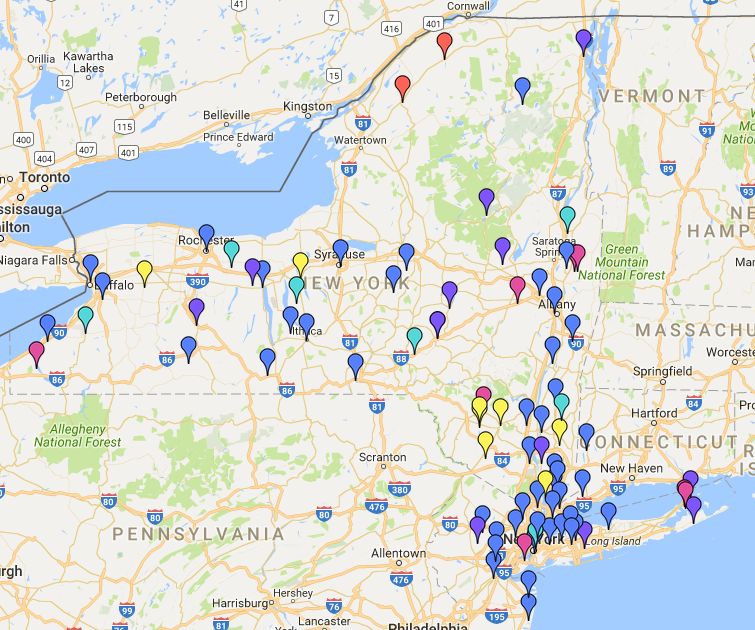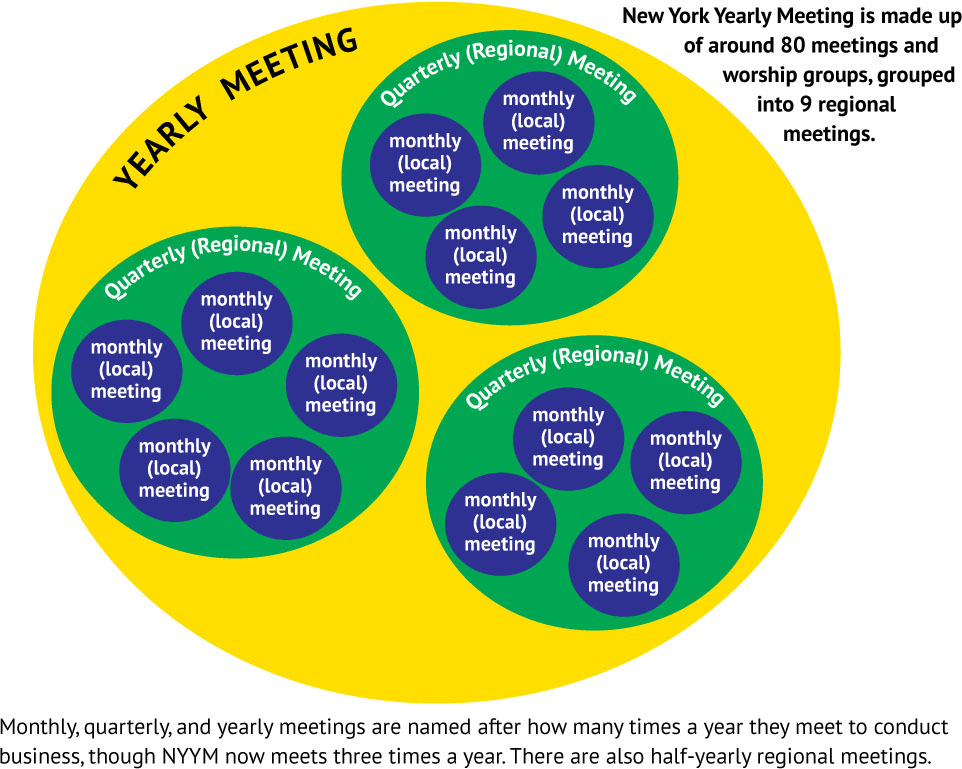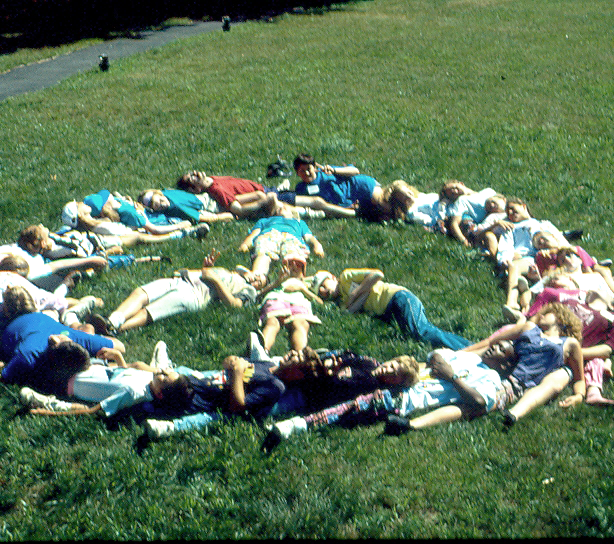Report of the General Secretary, Fall Sessions 2011
General Secretary’s Report
Fall Sessions 2011
Our financial condition is an aspect of our spiritual condition. How we are in our connection to God, in the coherence of our community, in our faithfulness, in our inspiration to fulfill the work we are led to do, and in our joyful response to God’s presence, guidance, and empowerment, are reflected in our budget and our commitments of our time and talents.
We once again are facing a challenging budget situation. This may seem like pretty familiar territory. I have not experienced an easy budget process in all the years I have been here, and judging by what I have read from the past two or three decades, having a challenging budget process, with concerns about what will be cut and where the money will come from to support the Yearly Meeting programs, has been more of the rule than the exception. So this may seem like the same old place we have been in, and therefore not much to worry about. But I would say that this year is somewhat different in the degree to which we are not just trimming the little bits of fat remaining, but really cutting into the bone with our proposed budget, impeding our capacity to give vital nurture to the Yearly Meeting as a whole. We cannot continue in the course we are on, of trying to whittle away the budget a little more each year without addressing the larger issues which impede our work as a community. Fortunately, I believe that we are now addressing those larger issues, but that it will take some years for that work to bear fruit.
Two years ago many of us had assumptions that the economy would improve and that that improvement would work its way down to the level of nonprofits, always the last segment of the economy to recover, in two more years, at most. Well, we are there now, and while Wall Street has recovered moderately well, the rest of the economy has not. We can’t expect an improved economy to pick up our budget for at least another two years, if then. Meanwhile, in some of our monthly meetings, the patterns of giving are changing. Many meetings have been largely sustained by several donors who have been exceedingly generous over the years. And in many of those meetings, those Friends are moving away as they enter retirement. As yet, other Friends have not increased their donations to offset this loss. In some meetings smaller numbers have also meant a smaller base of Friends contributing to their meeting.
The way we have been doing things will not work much longer. We are straining at the seams, and by this “we,” I mean most all of us in the Yearly Meeting—monthly meetings in their budgets and the yearly meeting with its budget. Our monthly meetings have been incredibly supportive of the Yearly Meeting budget, stretching mightily to maintain a flat level of giving. We are hearing from them that with the changes in demographics and giving patterns, that many are concerned about maintaining that level.
I believe that the change that is being forced upon us could ultimately be to our benefit. We are being asked to grow and change the way we do things. If we do, I think we could do very well. If we continue in our old ways of doing things, we will continue on the trajectory we are on, and it is untenable. It is not just untenable in terms of our budgets, monthly meeting and Yearly Meeting, but in terms of the health of our Society.
For some years now, the Yearly Meeting budget has been pared down and pared down, keeping it relatively flat over the past six or more years, despite increases in fixed costs, all the while expanding programs. We have done this partly by cutting out what we could, by economizing mightily, partly by reducing our support of the umbrella Quaker organizations, and partly by tapping funding sources outside our operating budget. Grants from the trustee-managed accounts and from outside sources have been vital in nurturing our growing edges, such as the Young Friends in Residence (YFIR) program, the ARCH program, and the young adult field secretary position.
In our Yearly Meeting operating budget most of our energy and resources are being devoted to trying to maintain what we have. And, with our current patterns of doing things, we are struggling mightily to do even that. We are not finding room to fund our growing edges. “Maintenance budgets” stifle our capacity for the Yearly Meeting to nurture those growing edges, where new life in the Spirit most needs our support.
I think it is easy to assume that the reason that we have pared down to maintenance budgets is that we haven’t the resources in these difficult economic times. While it might be easy to maintain the attitude that we always stretch to meet our budget, that this situation is no different than other years, that our vision will always outstrip our resources, and that we will therefore always be in this uncomfortable spot, I would like to present an alternative vision. I don’t see us as lacking in resources. I see us as having an inadequate vision to inspire Friends to share their resources.
Ruth Kinsey, beloved pastor of Farmington Friends Meeting, has shared in a message to her meeting the concept she calls “minimum-wage tithing.” The premise is simple: if everyone who is active in the meeting assumed only an income based on full time work at a minimum wage, and tithed on that amount only, she showed them that they could double or triple their budget.
Let’s do the math for the whole Yearly Meeting, understanding that we will be dealing with some gross approximations, but good enough for illustration purposes. If our roughly 3,500 active Friends each assumed an annual income of 2080 hours at $7.25 per hour, or $15,080 per year, and tithed on that amount to their monthly meetings, that “minimum-wage tithe” would net over $5¼ million.
Our monthly meetings give anywhere from 10–60% of their budget to NYYM, as led, but most are on the higher end, so let’s err on the high side and estimate an average of 50% of the budgets of our monthly meetings are currently going to support of the Yearly Meeting. As the Yearly Meeting’s budget is about $520,000, the net non-YM portion of our monthly meeting budgets would be roughly the same, or perhaps a little more. So cumulatively, monthly meeting budgets and Yearly Meeting budget, we are currently operating on about $1.4 to $1.7 million, or roughly a third of a minimum-wage tithe.
In our current practice, very few Friends give at this level. In the two meetings I have been a part of in NYYM, Bulls Head-Oswego and Poplar Ridge, only 5–15% of Friends give at this level. Most give a quarter or less than that. What concerns me most, and it also concerns monthly meeting treasurers that I talk to, is that a significant number of regularly attending Friends give $50 or less each year. I have heard that some Friends, especially newer ones, have had no idea that their meeting might be in need of contributions. We are sometimes so reluctant to talk about financial matters outside of business meeting that those who don’t attend have no idea how our finances work.
So while our monthly meetings are struggling mightily, I might even say in some instances, heroically, to support the work of the Yearly Meeting, we are not, as a group, giving much more than 3% of a minimum wage income to support the life of our part of the Society of Friends. While I know that there are many individuals who cannot afford even that amount, due to manner of employment, fixed income, children in college, or who out of conscience live below a taxable level, I believe that most of our Friends worshiping with us are making much more than minimum wage.
I am not advocating we move to a tithing system, or go back to an apportionment system, abandoning covenant donations. Acting as led, rather than in a prescripted fashion, is the heart of who we are. But as tithing is a predominant way in which other spiritual communities express their joyful commitment to the mission they feel called to, I think it serves as a good illustration of the point I hope to make. That is, that we, as a body, underfund our monthly meetings relative to the resources at our disposal.
We have the resources. When Powell House’s boiler blew, and they needed $49,000 right away, the money appeared. When Ithaca monthly meeting became clear to buy and remodel a building for a new meetinghouse, they raised over $300,000 in a matter of months. When Old Chatham monthly meeting became clear that they needed to not build their meetinghouse on Powell House property, but instead buy land costing almost as much as what they had raised to build their meetinghouse, they bought the land. And then they raised the money for their meetinghouse a second time.
We have the resources. Much of the time, we just aren’t inspired to use them in support of the Society of Friends. This isn’t because we aren’t good and generous people. We are. It’s because there is a disconnect between those doing the work in the name of the Yearly Meeting, and those paying for it. Many Friends in our monthly meetings know little or nothing of the work going on in their name. It’s pretty hard to be inspired to support something you know virtually nothing about. And it is an open question as to whether the work being done through the Yearly Meeting budget is an accurate expression of the needs, leadings, and desires of the Friends who make up this Yearly Meeting. It could be. We hope that it is. But we don’t know for sure.
If we have a coherent vision that is grounded in the discernment of our communities, and it is clearly communicated, and the extent of the needs to support that vision, both locally and in the larger Yearly Meeting, are made known, I firmly believe that we will have all the support we need to do that work. And, we will be healthier spiritually for doing so.
We are now part way through that process of addressing what I would sum up as: Vision, Communication, and Development. We need to be working from a common vision. Arriving at a common vision will involve better communicating as to what we are doing, and a lot of grassroots listening about what is needed to nurture our monthly meetings and individual Friends, how we are being led, and how what we are currently doing needs to be better aligned with the needs and leadings across the Yearly Meeting. If we do that work well, I believe Friends will be inspired to support the work. Communication and Vision are thus intertwined. Our Priorities Working Group has been designing a process whereby we can do this work of listening, communicating, and envisioning together. Expect a request from one of them to visit your meeting.
In the area of Development, it is clear that we need to do a better job of supporting our monthly meeting budgets. If our monthly meetings are doing well, the Yearly Meeting organization will do fine, if its vision is consonant with the whole of the Yearly Meeting and is communicated effectively. The Development Working Group has been responding to the Financial Services Committee’s request that we create a Development Committee. Much of the preliminary discussion has been about how the Yearly Meeting can better support our monthly meetings in their fundraising efforts. What we have found so far is that there is much that we can do in this area. We have been looking at how other yearly meetings do this work and also whether some sort of development function in support of the Yearly Meeting’s work is feasible and advisable. We have arrived at a tentative “yes” to this question and will be bringing that discussion to General Services Coordinating Committee this Fall Sessions.
We are doing what needs to be done to move into a different pattern of how we fund the Life of our monthly meetings and our Yearly Meeting. I anticipate us drawing together behind a common vision, having a broader understanding of the work we do, and moving into a different attitude and practice around funding our work. If we do this well, we will embark on a different trajectory, one that nurtures our growing edges, one of less stress, strain, and struggle, deeper faithfulness, and more coherent community.
In closing, I would like to tell a story about my friend Sandy, when I was new to Twin Cities Friends Meeting. I had been attending meeting a year or two and was deeply impressed and surprised when I learned that Sandy was giving $25 a month to the meeting. Sandy was a single mom, who worked very hard to make ends meet, at a job that didn’t pay terribly well. In today’s dollars, her giving would be more like $50–75 per month. At the time, I had my own building-contracting business, and was able to be pretty comfortable. Yet Sandy was giving way more to the meeting than I was. It was her commitment, and she honored it resolutely. What I also saw was that living that commitment deepened her relationship with the meeting. She was more a part of it than I was, partly because she gave, and partly she gave because she was more connected. I was more of a consumer, appreciating what the meeting had to offer but not invested in that deeper relationship.
I lost out on a great deal due to that attitude, one that fortunately changed over time.
If we all behaved as my friend Sandy did, a single mom with a mortgage, a young son, and very limited means, we would all be the richer for it. And so would our meetings. And that will not happen unless and until we are inspired to do so by the vision and the work set before us. We have some work to do to get there. Let us be faithful to it.
This item was presented at
More Resources like this may be found at





